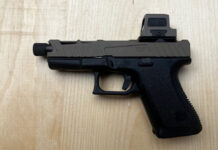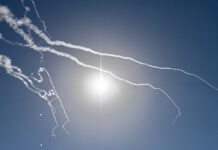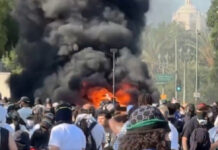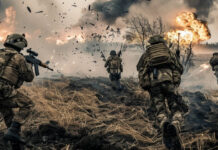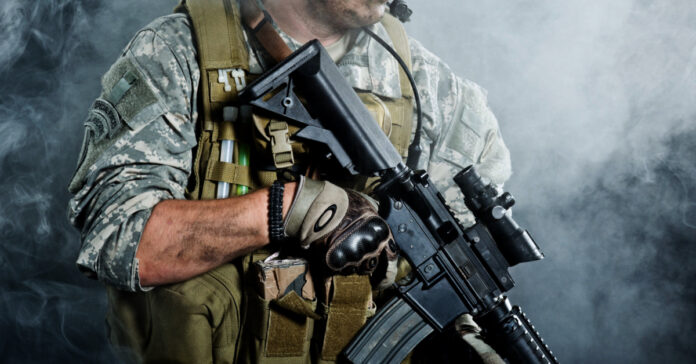
For two of the past three nights, I have gone on my midnight dog walk with an AR 15 slung on my chest and a spare magazine in my pocket.
I am not doing this because of any immediate threat. We haven’t seen any bears this fall, and I am not worried about being mugged or accosted by any humans in the middle of our woods at 1 a.m. Besides, I already carry a Glock. No, I’m carrying a rifle for practice.
Before you think to yourself, “Pete’s a crazy LARPer,” let me ask: When was the last time you carried an AR15 further than the distance from your gun safe to the car? When did you last make sure your sling was set up perfectly? Have you checked that the 1,000 lumen long-throw flashlight on your rifle works? When was the last time you used it and your optic to aim at something 150 yards away in the dark?
If you can’t remember, then maybe you should get out there and practice, too. Unless you want to find out too late that you can’t transition to use your rifle on the left side of a barricade because of how your sling is set up. Or you find out your batteries are dead when you are trying to get a bead on the three guys who are running through your neighborhood setting houses on fire. Or you learn your rifle slams into your pistol holster with a loud noise when you are hiding and noise discipline is important.
I’m just saying.
Practicing Carrying, not Just Shooting
Too many preppers go to the range a couple times a year, fire three or four magazines and think they have met their training requirement. In the event they have to engage a static enemy at known distances on a flat field with a solid backstop while sitting at a shooting bench, then they may be right. But if they have to hike a mile, take an uncomfortable shooting position behind a rock, and engage an enemy moving from left to right at an unknown distance, they will likely find their range practice was insufficient.
Carrying my gun in the woods, sometimes while wearing a plate carrier or a chest rig, is good practice, even if I just dry fire.
Practicing constant carry and living with a rifle is important for preppers who expect to depend on firearms for self-defense. After the SHTF, I expect to be carrying a rifle almost constantly, including on the way to and from the latrine. If you do too, then you need to be able to live with your defensive weapon without having an accidental or negligent discharge, without sweeping others or otherwise endangering yourself and your team members. Practicing this kind of gun handling now—when there is no threat and you can do it with an empty chamber—will make a difference then.
Games with Guns
Over the years, I’ve shot bullseye, USPSA, IDPA, steel matches, three-gun matches, long range matches, and in a police league, competing up to state-wide and regional matches in some disciplines. All of them are useful for building skills, even though the skills you learn from an old bullseye match differ from those in a modern three-gun match.
More importantly, they all count as practice. Practice gun handling, including drawing and firing, reloading, and shooting while moving, all under the eye of a range master who will help keep you from doing something stupid or dangerous. Some matches will give you practices shooting behind a variety of barricades and at different ranges. For example, I’ve shot a stage where you shoot your pistol at man-sized targets at 20 yards and then have to engage steel targets with your rifle at 275 yards. That’s a scenario you probably won’t set up and practice on your own.
I encourage you to compete in gun games, as long as you don’t fall into the habit of thinking a real confrontation will be like that. Shooting competition can help you gain skills and experience shooting under pressure, but if you are not careful, games can also teach you bad habits, like not using cover.
Complications
You can’t learn everything at a gun range, which is why I practice at home and in the woods.
I believe you need to be able to safely carry your weapon in multiple ways. For example, if you are in a safe zone and you need to get from point A to point B, you may carry a long gun slung over your back with an empty chamber in a manner suitable for transportation. If you are patrolling an area where you believe there may be an incursion by unfriendlies, you want to carry the gun in your hands so that you can return fire if fire upon. There may also be times when you need get in or out of a vehicle while carrying along gun. You also need to figure out whether to set down your weapon or sling it differently while you sit down to eat, poop, or dig in the garden. Better to work out those details and get some practice now.
This is what living with the gun is all about. You need to get to the point where you can do all those day-to-day things unconsciously, and that takes practice and repetition. Getting those reps in now will be important if you ever are forced to go from LARPing to life and death.
One complication for me is walking the dog. When doing so, I usually carry a hiking stick, which is a wooden staff that can serve as a striking weapon. Can I carry a rifle while holding the dog leash in one hand and a hiking stick in the other? Not easily, so I leave the hiking stick at home. I’ve already practiced dropping the leash to draw my pistol. Doing so to use a rifle is similar, but also requires practice.
How your rifle interacts with other gear, from your handgun to your backpack, is also important.
Fear the Man who has One Gun
An old saw goes: Fear the man with one gun because he probably knows how to use it. Just because it is old doesn’t mean it is inaccurate.
I have multiple guns and multiple AR15s, but one is my primary gun. It is my go-to AR, and this is what I intend to use after the SHTF, so it is what I carry now when I do my midnight patrols.
The particular rifle is one of my favorite ARs because I used it in three-gun matches for several years and I therefore consider it “proven.” It’s not my lightest rifle, but it’s reliable.
It’s good for late night walks because of the light, which has a much longer throw than either my headlamp or my handheld flashlight. (The police league had at least one night shoot a year, which is where I learned the value of a long-throw light.) It also has a double-point Magpul sling that is adjustable enough to let me carry it in at least three configurations.
I first assembled this gun in 2009 and over the years since I have upgraded it. For example, at some point, I replaced the old quad rail handguard with a slimmer fore end. I also removed the rather basic (and very cheap) adjustable shoulder stock and replaced it with the Magpul ACS, which is my favorite stock for an AR when using an optic. That not only made the gun more comfortable to shoot, it eliminated the old stock’s rattle and gave me a place to store some CR123 batteries for the flashlight. The stock also stores tiny hex keys I can use if I need to tighten up the flashlight mount or an optic. The pistol grip holds batteries for the Aimpoint optic.
Gain an Edge
Having a gun set up not only the way you want it, but the way you have practiced with it, can give you an edge over someone who has limited experienced or never left the range.
If it comes to defending myself or my property after the SHTF, I want every edge I can get. Setting up a gun that fits me and my shooting style is something I can do now but won’t be able to after the SHTF.

